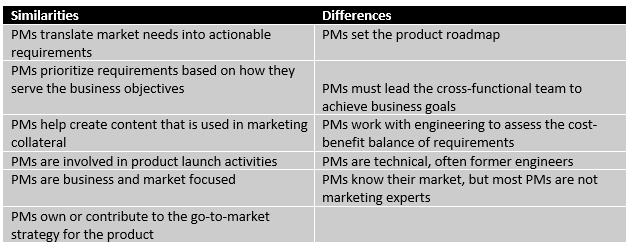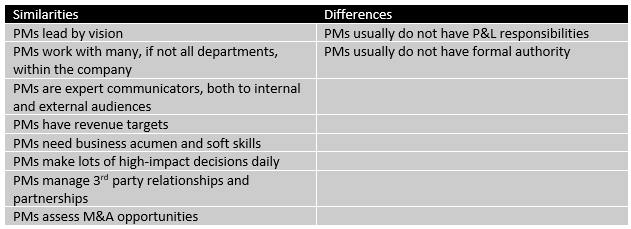top 6 commonly used LABELS for product managers & why you should care
Product management may never be as broadly understood in an organization as traditional functions such R&D, engineering, HR and accounting, but the core product teams, the representatives of the various functions that work together to create successful products, should have a good idea what product management does and does not do, and how it adds value to the organization.
Product managers are called many names. Some of them require thick skin. Some capture the essence of the job, but with caveats. And some are just plain misguided. Regardless, they represent feedback about how product management is viewed in the organization and highlight areas that may require attention. Are they the manifestation of inadequate corporate communications? Is it a change management issue that should be addressed via organizational tactics? Is it related to a PM skill gap? Is it due to a personality conflict?
If you are the champion or guardian of the product management function within your organization or you are interested in establishing a product management framework, it is important to recognize that these ‘names’ can be barriers to successful acceptance of the initiative, and can be challenging for the product manager to overcome without executive sponsorship and support.
Below are the top 6 names for product managers that I have come across. The distinctions are not exhaustive; only what I considered important are included in the two columns. Each includes a short description of why the mislabeling might occur and contains suggestions on how to address them.
1. Project Manager
I think every product manager at some point during their career has encountered this one.
In my experience, when PMs are referred to as Project Managers it indicates one of two issues: 1) the PM role has never been clearly explained to the person making the comment, or 2) the person understands what product management should be, but the way it is currently executed appears to be heavy on project management. In both cases, additional communication about the role could be beneficial. Instead of “training sessions” it may work better to do this in an indirect manner. For example, quote the PM on product vision in the internal newsletters, let PMs organize sales training events, encourage PMs to be active on technology related newsgroups, etc. In the latter case further investigation may be necessary as the perception can originate from the PM’s lack of confidence or skill, from personality conflict, etc.
2. product Marketing
“Oh, you make the marketing material for the product fun to read.”
PMs talk to customers, help write web content, go to trade shows, author articles in trade journals, etc. Product Management as a function is sometimes under Marketing on the organogram. So the confusion is not surprising and may not seem like a big deal. However, when the development team shares this view, it should be addressed as it is a symptom of a deep disconnect and does not allow for productive team dynamics.
A common cause for this particular misconception is that the PM has not succeeded in building credibility to be viewed as the product leader, or perhaps she acted in ways that destroyed her credibility. Another possible cause is resistance to change due to fear of losing control as some of the familiar routines have been disrupted. With the introduction of product management, clear communication on how roles and responsibilities will change, and how they are relevant is key in this case.
3. Project Administrator
The note-taking, meeting organizing busy bee.
Similar to what has been said about PM when confused with project management, regularly reiterating the role of product management in various internal communications goes a long way in clarifying this common misconception. The administrative component of the PM role can be quite significant, and it can be easy to mix up a strong pragmatic framework with it being a mindless use of checklists and templates.
4. Product Mini-CEO
The first use of this analogy is attributed to Ben Horowitz. He used it as a way to encourage ownership.
Although this comparison is still valuable in conveying how a PM should approach the role (take charge), when misunderstood the mini-CEO label can lead to an authoritarian, dictatorial PM, which is rarely effective in product management in the long run. PMs have to change mindsets, communicate product vision and move people in a new direction without formal authority. Roman Pichler provides a nice summary of the pros and cons of the main leadership styles in the context of product management.
Another misleading aspect of calling product managers “Product Mini-CEOs” is the over-focus on the product. It may drive some product managers to become product experts familiar with the features, underlying technology and operation of the product, while neglecting market research, customer behavior, business strategy and other equally important aspects of the job.
Watch out for the above two behaviors if mini-CEO is commonly used in your organization to describe product managers.
5. Product Owner
The person that produces requirements in such detail that it can be implemented by the developers/engineers without much additional interaction.
The main distinction between a PM and a PO is that PM's always have a wide range of externally focused activities such as tracking market dynamics, engaging with customers, creating roadmaps, generating sales enablement programs, developing go-to-market strategies, etc. POs are internally focused and their primary responsibility is to ensure that developers have a clear and actionable set of requirements/user stories to implement for each sprint/iteration. PO is also a SCRUM term, and POs are part of the SCRUM team.
An organization often would start out with a PM that does it all. When the workload becomes such that the role has to be divided, the PO role is introduced. The PO covers the internally focused responsibilities of the product management role. PMs and POs have regular meetings, often multiple times a week, to ensure market-driven alignment between the long term goals and the short term effort.
6. Product Champion
In my experience, product champions usually are product managers, but with a different balance between the various activities involved. They are evangelists who constantly engage with the market to ensure that the product gets the mindshare it deserves with consistent messaging and positioning.






